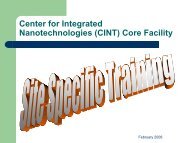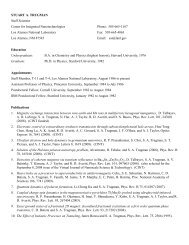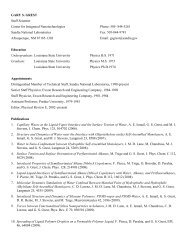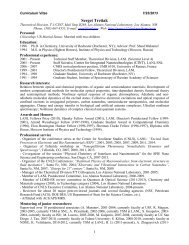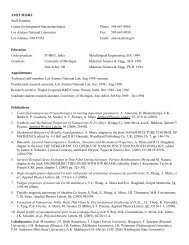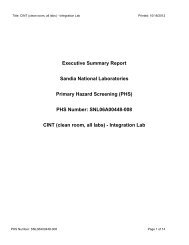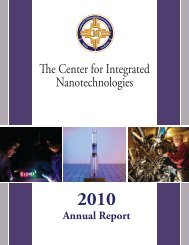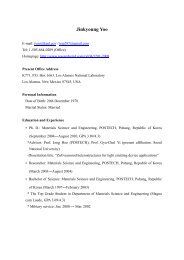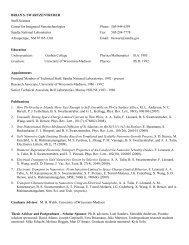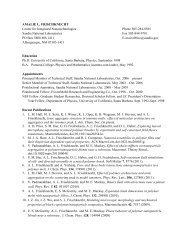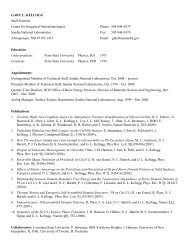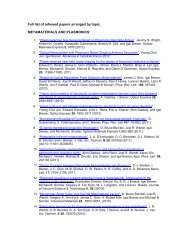2011 Annual Report - Center for Integrated Nanotechnologies - Los ...
2011 Annual Report - Center for Integrated Nanotechnologies - Los ...
2011 Annual Report - Center for Integrated Nanotechnologies - Los ...
You also want an ePaper? Increase the reach of your titles
YUMPU automatically turns print PDFs into web optimized ePapers that Google loves.
Discovery Plat<strong>for</strong>ms<br />
TEM Liquid Cell Discovery Plat<strong>for</strong>m<br />
We have completed the successful fabrication and demonstration<br />
of a new CINT DP that provides a unique capability to per<strong>for</strong>m<br />
experiments inside a transmission electron microscope using<br />
volatile liquids, such as aqueous solutions or battery electrolytes.<br />
This plat<strong>for</strong>m, the TEM Liquid Cell DP, uses two microfabricated<br />
chips, each having a thin silicon nitride window (~ 40 nm thick),<br />
that permits transmission of high energy electrons with little<br />
attenuation. The two chips are mated face-to-face to create a<br />
narrow a cavity, approximated 100 nm thick, see Fig. 2. Liquids<br />
are inserted in this cavity through two fill holes which are<br />
subsequently capped with epoxy to create a sealed liquid-filled<br />
chamber. Metal electrodes are also provided into the viewing<br />
region of the plat<strong>for</strong>m in order to permit the observation of electrochemical<br />
processes while imaging in the TEM. The plat<strong>for</strong>m<br />
has been tested with the assembly of LiFePO4 Li-ion battery<br />
cathode nanoparticles, using dielectrophoresis, and with filling<br />
and imaging through an ethylene carbonate based Li-ion battery<br />
electrolyte. Future work with this plat<strong>for</strong>m will focus on imaging<br />
the <strong>for</strong>mation and evolution of the solid-electrolyte-interphase<br />
layer on Li-ion battery electrodes.<br />
Microfluidic Synthesis Discovery Plat<strong>for</strong>m<br />
CINT has begun development of a new Microfluidic Synthesis<br />
Plat<strong>for</strong>m to advance both the science and practice of nanomaterials<br />
synthesis. The goal is to develop customized microfluidic<br />
chips, along with necessary temperature and fluidic controls, to<br />
allow improved control and in situ study and monitoring of nanomaterials<br />
synthesis. In particular, targets include greatly improving<br />
reproducibility of syntheses, on-chip synthesis of core-shell particles,<br />
as well as on-chip surface functionalization. These goals<br />
necessitate novel chip designs as well as advanced temperature<br />
controls, including multiple heating zones on a single chip. The<br />
supporting system is being assembled, and the now chip designs<br />
fabricated and tested in consultation with the user community, in<br />
particular with Professor Ping Liu (UT Arlington). In situ monitoring<br />
systems are currently in the planning stage but will be deployed<br />
in the upcoming year.<br />
Figure 2. The TEM Liquid Cell Discovery Plat<strong>for</strong>m. Two microfabricated chips with<br />
electron transparent windows are mated face-to-face to create a thin cavity that is then<br />
filled with liquid and sealed. The image on the right shows the assembled plat<strong>for</strong>m on<br />
a TEM holder.<br />
We will use the newly fabricated TEM Liquid Cell DP to investigate<br />
electrochemical mechanisms at solid electrode – liquid electrolyte<br />
interfaces. This work is complementary to the in situ TEM<br />
work involving open electrochemical cells using ionic liquid or<br />
solid electrolytes, as described in the NEM thrust activities. The<br />
goal of these studies is to image the <strong>for</strong>mation and evolution of<br />
the solid-electrolyte-interphase layer on representative Li-ion battery<br />
nanoscale electrodes, including silicon and graphite anodes<br />
and LiFePO4 and LiMnxO2 cathodes, while these electrodes are<br />
immersed in ethylene carbonate-based Li-ion battery electrolytes.<br />
The sealed cell geometry of the TEM Liquid Cell DP permits<br />
future experiments that are aimed at understanding cell aging<br />
mechanisms. These studies will be per<strong>for</strong>med by cycling sealed<br />
cells outside the TEM <strong>for</strong> periods ranging from days to weeks<br />
interspersed with periodic TEM imaging and analysis. This offers<br />
a view into long time scale degradation phenomena, an approach<br />
normally not possible in TEM electrochemical experiments. As<br />
an exploratory activity, we will also test imaging of the TEM Liquid<br />
Cell DP using aqueous solvents, with the goal of assessing<br />
the suitable of this plat<strong>for</strong>m <strong>for</strong> analysis of chemical synthesis or<br />
biology processes (in collaboration with the Soft, Bio, Composite<br />
Thrust).<br />
15





